BIOCOMM 2018
Savannah, Georgia
June 19-22, 2018
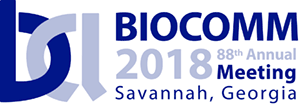
Savannah, Georgia
June 19-22, 2018
Meeting Highlights
BIOCOMM 2018 – an Outstanding Success
A big thank you to our presenters and attendees from around the world who contributed their time and effort to make BIOCOMM 2018, BCA’s 88th Annual Meeting in Savannah, Georgia, June 19-23, 2018, a huge success!
The meeting offered three days of presentations and workshop sessions that brought together a variety of professionals in the fields of visual media in the life sciences. An additional day was added for a location workshop guided by Bill Durrence.
The meeting kicked off on Monday evening with the BioImages 2018 Opening & Awards Ceremony. BioImages is the BCA’s annual visual media competition that showcases the finest still, graphics and motion media work in the life sciences and medicine. There were 194 entries this year, 118 of which were selected for the salon. A total of 41 awards were given.
This year’s Best of Show was C Section “It’s a baby girl” by David Bishop, BSc of The University College London, London, England. David also received an Award of Excellence for Decellularised human liver – Dr. Giuseppe Mazza.

This year’s judges were Paul Crompton, FBCA, recently retired as Director of the Media Resources Centre at the University Hospital of Wales in Cardiff, UK; Marie Craig, MS, Co-Founder and Co-Director of Fountain Street Fine Art; Kathleen Wagner, MFA, CMI, retired as Associate Director of the Medical Graphics & Photography Department at the MD Anderson Cancer Center in Houston, Texas; and Will Willner, RBP, FBPA, an Adjunct Instructor in Photography in the Art Department at Wake Forest University.

The annual meeting kicked off with an impactful presentation from our Maria Ikenberg Lindberg Keynote speaker, Andrew Davidhazy. His presentation title, Adventures in Human-Centered Design and Photography, describes how his career has taken him a round the world and how his experiences have influenced his work. Andrew’s top four priorities are focus on culture, the landscape - people, family, help and hope. He immerses himself in the uncomfortable with a goal to accomplish things that make him proud. His key to achieve this is through observation, transformation and working on projects that inspire him. The take away – inspirational! Andrew is an amazingly talented designer and photographer that credit his innovative works to the human-centered experiences he has encountered around the world.
Next on the schedule was Jim Wetzel who presented on the topic of Modeling Sharkskin: A microscopic Study in Bio-mimicry. Bio-mimicry is an approach to finding sustainable solutions to human challenges by copying nature’s patterns. Jim was inspired by a study that copied the pattern of sharkskin, created 3D models of the sharkskin, and demonstrated bio-film formation and bacterial growth could be minimized. Jim is working with several species of sharks and working on some preliminary results for the reduction of bacterial adhesion. It was a fine example of combining photography, nature and science.
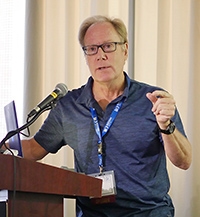
James Hayden presented an overview of widefield, confocal, and 2-photon excitation microscopy. Each method has it’s own pros and cons. At his lab much of his work involves photographing living cancer cells. Two-photon microscopy allows imaging of living tissue up to about one millimeter in depth. In addition 2-photon does less damage to living cells and the specimen is more protected.
David Graham, DVM, PhD shared his techniques for converting select extant 2-D images into 3-D images yielding the 3-D effect by stereopsis. Attendees were invited to submit images to use in a demo of 3D conversion workflow.
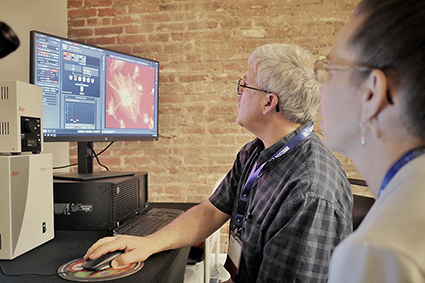
The afternoon was scheduled for 2 workshops. Jim Wetzel and Jamie Hayden provided microscopes for hands-on photomicrography. David Graham hosted a workshop on 2-D to 3-D conversion of digital images. Attendees were free to choose the workshop they wanted or split their time between all three.
Day two began with a presentation from Paul Crompton, FBCA, In Their Features and Countenance – The Study of Medicine. Paul is in the process of writing a book on the history of medical photography. He found the task was quite extensive and made the decision to write the history of medical photography up to the 1900s. As early as 1802 physicians used photography as a means to document and study medicine.
Ken Meats has video taped the BIOCOMM oral presentations for 3 consecutive years. This year Ken discussed the tools he uses to record, do screen capture, edit and upload the presentations to BCA’s YouTube channel.
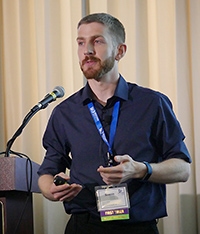
Simon Wells, who also served as the official event photographer, gave a presentation on Optimising photo dermoscopy practice – to improve diagnostic accuracy. Simon has established a procedure for taking photographs using the dermoscope that are standardized in capturing the images and the post-production workflow. Ideally the photographer should learn to use the dermoscope as seen through the physician’s eye. His aim is to establish ”best practice” standardization for other medical photographers to use. In addition, the standards he has established shows evidence it can potentially improve diagnosis accuracy.
Lunch was provided for the Business Lunch/Town Hall Meeting. The business lunch covered elections, the annual financial report and reports from each of the directors. Susanne Loomis, FBCA is President, Adam Cooper, RBP, FBCA is Vice President, and James Koepfler, FBCA is Secretary/Treasure. The Town Hall meeting covered topics concerning the cost to BCA for the annual meetings, membership, where the meeting will be held next year, pros and cons of a virtual meeting beyond 2019.
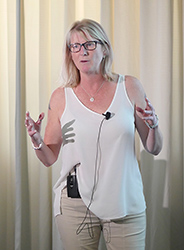
After the business lunch, Kathy McFall, the 2018 Schmidt Laureate gave a presentation on A Secure Clinical Photo App. Kathy is head of Medical Illustration Services at the NHS Greater Glasgow & Clyde, Queen Elizabeth University Hospital. Her institution recently purchased the Secure Clinical Image Transfer (SCIT) app that was developed to allow healthcare staff to capture clinical photographs on mobile devices. Kathy discussed the research that went into purchasing this app, the use of the app within the UK governance and the integration with their existing system.
The day wrapped up with Show Your Stuff/Infoshare, moderated by Adam Cooper. Sue Loomis talked about the 3D printer she acquired and how she’s using it on the job. Paul Cromptom discussed the Mothers of Africa photography book and digital story telling projects he is working on. Jamie Hayden demonstrated a sling neck strap that he loves using for location photography. Ken Meats gave a quick overview of DSLR for video recording. For those who are using their DSLR for shooting video he offered some great tips. Ken uses the add-on software Magic Lantern for his Canon and recommends Nikonhacker for Nikon users.
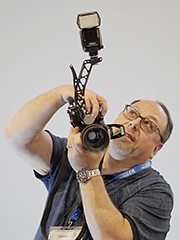
Adam Cooper talked about flash brackets he’s found useful for event photography. A favorite is his boomerang bracket. Most of his gear he finds on the Pro Media Gear website. Katharine Hanlon said a career counselor had contacted her for information about careers in medical photography. Before responding to the counselor Katharine asked the attendees for their ideas and thoughts for pursing careers in medical photography.
The last item on the program was a tour of the Photography facilities at the Savannah College of Art and Design (SCAD). This is a private college with state-of-the-art facilities, outstanding studio space and even the cameras and computers are furnished. Graduates generally seek careers in advertising, fine art, and education.

Friday was another full day of presentations. Denise Smith, PhD, Associate dean, School of Communication Arts, SCAD Atlanta, gave a presentation on the hypothesize that ancient Mississippian ceremonial grounds were intended to symbolize the cosmos. Dr. Smith has published and lectured on rock and stone art, and Native American art throughout North America.
Next up was Katharine Hanlon, a medical photographer at Mayo Clinic in Florida. Katharine presented her standards for using cross-polarized and parallel-polarized light in clinical photography. With examples she explained how the use of polarized photography can also provide detailed information on skin pigmentation and subsurface skin features using post-processing techniques.
Long time friend to BCA, Bill Durrence, gave a presentation on Going Mirrorless, My Most Recent Transition in 50 years of Adapting to Change. As a Nikon rep he had tons of camera gear to take on location. Bill has packed up all his old gear and now travels with a lightweight Fuji X-T mirrorless system. After all the images he showed using the mirrorless system, everyone wanted to go out and purchase this camera.
Bill Fortney, another long time friend of BCA, workshop leader and Nikon rep was up next. Bill’s presentation, Seeing the Light, was an overview of some of the finest examples of how Bill used the most effective-light possible.
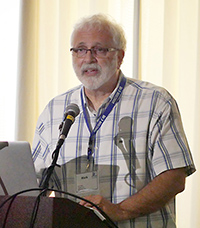
The final presentation was the Anne Shiras Pioneer Lecture and came from Mark Maio, Photographic Life Lessons. Mark’s career is split between science and art photography. At a very young age he wanted to be the next Ansel Adams. He pursued many careers in photography but found his niche as a medical and ophthalmic photographer for 25 years. Mark developed the first high-resolution digital imaging system in ophthalmology and now works as a consultant, educator, and workshop leader and still finds time for fine art photography. His images were as inspirational and impressive as his career in photography.
The Honors Banquet and Award Ceremonies were held on Friday evening. After a fine reception and dinner, the Award ceremony began. Peter Grattan, RBP, was awarded Emeritus Membership, and BCA Fellowship was awarded to Hoosain Ebrahim and Ken Meats, RBP. Kathy Jane McFall, RBP, FBCA, was awarded the 2018 Louis Schmidt Laureate for “outstanding contributions to the progress of biological communications.”
Bill Durrence guided the post-meeting workshop. At 4:40 AM the group boarded a shuttle and drove to Tybee Island for the beach sunrise. After a few hours on the island the group headed to historical Fort Pulaski, part of the National park system. After a day of exploring and photographing these beautiful sites the group met back at the hotel for review and critique of their work.

To sum it up, as one attendee commented, “BIOCOMM 2018 was an outstanding success. BCA is a wonderfully congenial group and well worth the trip to Savannah.”
We hope you will join us next year for BIOCOMM 2019 at Asilomar Conference Center in sunny California! The dates are set for June 18-22, 2019 and more details are coming soon!
